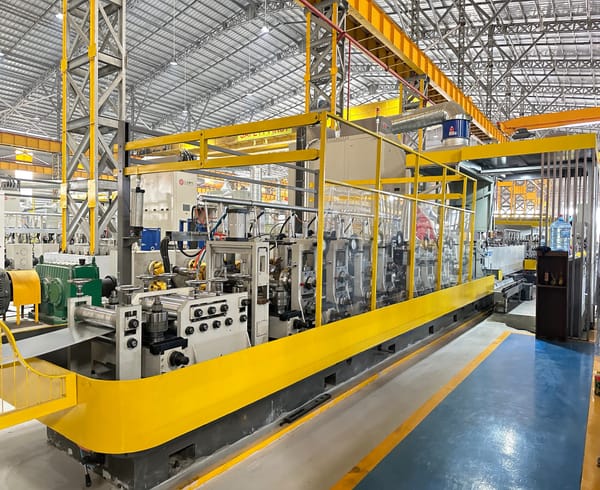
After passing through the loop accumulator, the continuously fed steel strip enters the heart of the ERW tube mill: the Forming, Welding, and Sizing Section. This is where the flat strip is transformed into a tubular shape, welded, and then precisely sized to meet the required dimensions.
Forming Section
The forming section consists of a series of rollers, often referred to as forming stands. These rollers progressively shape the flat steel strip into an open-seam cylindrical form. The process begins with initial breakdown passes that gradually bend the edges of the strip upwards, followed by fin passes that bring the edges closer together, creating a precise 'V' shape at the top. The accuracy of the forming process is paramount, as it directly influences the quality of the subsequent weld and the final dimensions of the tube. High-precision forming stands often utilize advanced coupling mechanisms to ensure extreme accuracy in maintaining the tube's diameter and shape.
Welding Section
(Electric Resistance Welding - ERW)
Once the strip is formed into an open-seam cylinder, it enters the welding section. Here, the two edges of the 'V' converge, and a high-frequency electric current is applied. This current flows through the edges of the steel, heating them to a plastic state, just below their melting point. Simultaneously, pressure rollers (squeeze rollers) apply mechanical force to forge the heated edges together, creating a strong, solid-state weld without the addition of filler metal. This process is known as Electric Resistance Welding (ERW). The heat generated by the resistance to the electric current, combined with the pressure, creates a metallurgical bond between the strip edges. Any excess material (flash or bead) that is squeezed out during welding, particularly on the outside diameter, is immediately removed by a scarfing tool. Key characteristics of ERW: * High-Frequency Induction Welding (HFIW): Modern ERW mills predominantly use high-frequency current, often induced by an induction coil, to concentrate heat precisely at the strip edges, leading to faster and more efficient welding.
* Solid-State Weld Unlike fusion welding, ERW is a solid-state process, meaning the metal edges are forged together without fully melting, resulting in a clean, strong, and consistent weld seam.
* Speed and Efficiency ERW is a highly efficient process capable of producing welded tubes and pipes at high rates, making it suitable for mass production.
Sizing Section
After welding and scarfing, the newly formed and welded tube enters the sizing section. This section consists of another series of rollers designed to achieve the final precise dimensions, shape, and straightness of the pipe or tube. The sizing rollers can fine-tune the outside diameter, wall thickness, and ensure the product meets strict dimensional tolerances. For square or rectangular tubes, a direct forming and sizing section might be employed, where the flat strip is directly formed into the desired non-circular shape without first forming a round pipe. This section also helps to relieve any residual stresses from the welding process and ensures the tube is perfectly round (for circular pipes) or has the correct angularity (for shaped tubes).
In summary, the Forming, Welding, and Sizing Section is where the raw steel strip is meticulously transformed into a finished ERW pipe or tube, with precise control over its shape, weld integrity, and final dimensions.
